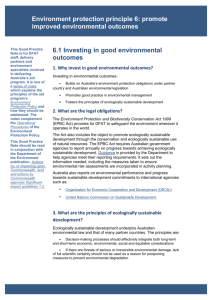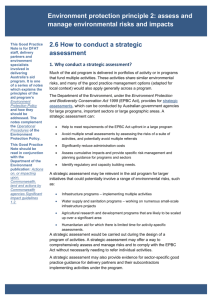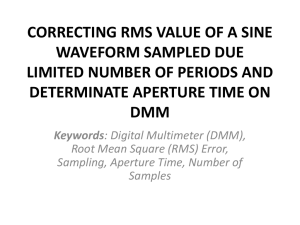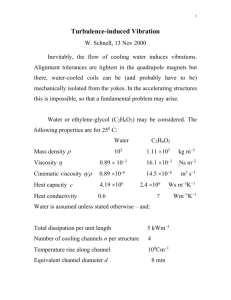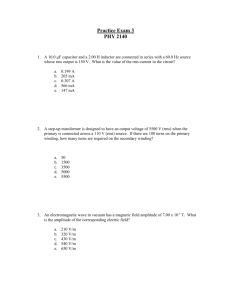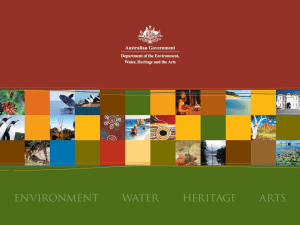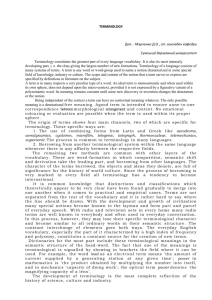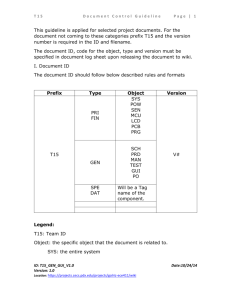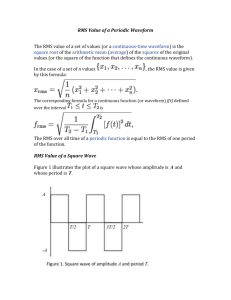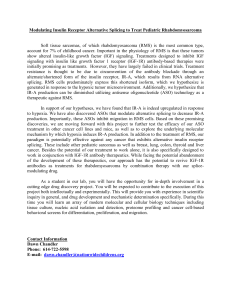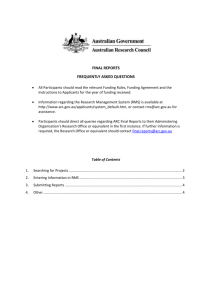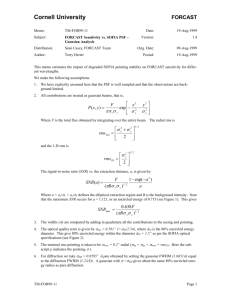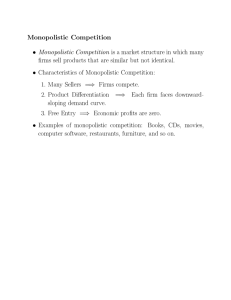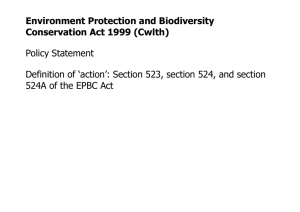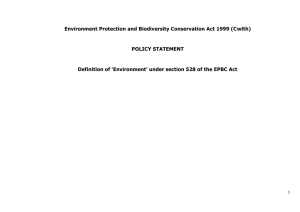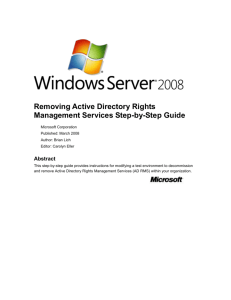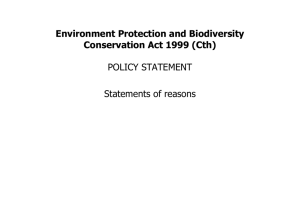SA023 - Agreement - Terms of Reference
advertisement
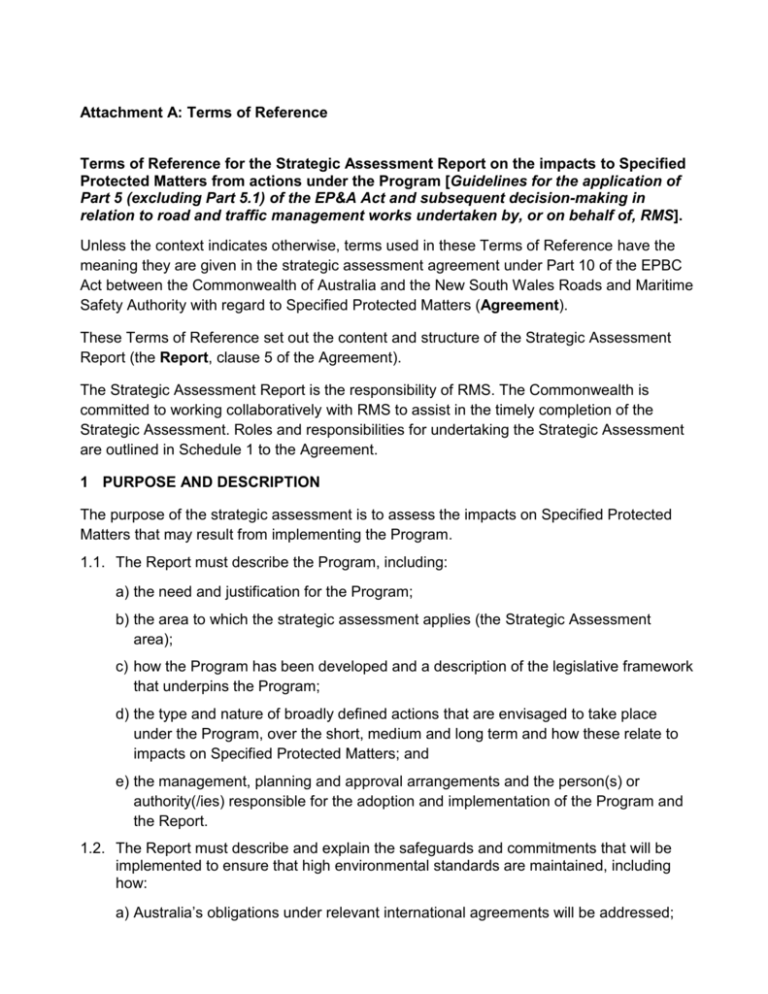
Attachment A: Terms of Reference Terms of Reference for the Strategic Assessment Report on the impacts to Specified Protected Matters from actions under the Program [Guidelines for the application of Part 5 (excluding Part 5.1) of the EP&A Act and subsequent decision-making in relation to road and traffic management works undertaken by, or on behalf of, RMS]. Unless the context indicates otherwise, terms used in these Terms of Reference have the meaning they are given in the strategic assessment agreement under Part 10 of the EPBC Act between the Commonwealth of Australia and the New South Wales Roads and Maritime Safety Authority with regard to Specified Protected Matters (Agreement). These Terms of Reference set out the content and structure of the Strategic Assessment Report (the Report, clause 5 of the Agreement). The Strategic Assessment Report is the responsibility of RMS. The Commonwealth is committed to working collaboratively with RMS to assist in the timely completion of the Strategic Assessment. Roles and responsibilities for undertaking the Strategic Assessment are outlined in Schedule 1 to the Agreement. 1 PURPOSE AND DESCRIPTION The purpose of the strategic assessment is to assess the impacts on Specified Protected Matters that may result from implementing the Program. 1.1. The Report must describe the Program, including: a) the need and justification for the Program; b) the area to which the strategic assessment applies (the Strategic Assessment area); c) how the Program has been developed and a description of the legislative framework that underpins the Program; d) the type and nature of broadly defined actions that are envisaged to take place under the Program, over the short, medium and long term and how these relate to impacts on Specified Protected Matters; and e) the management, planning and approval arrangements and the person(s) or authority(/ies) responsible for the adoption and implementation of the Program and the Report. 1.2. The Report must describe and explain the safeguards and commitments that will be implemented to ensure that high environmental standards are maintained, including how: a) Australia’s obligations under relevant international agreements will be addressed; b) there will be high quality assessment of the impacts of broadly defined actions on Specified Protected Matters; c) Specified Protected Matters are protected in accordance with the objects and requirements of the EPBC Act; and d) works undertaken by RMS will not have unacceptable or unsustainable impacts on Specified Protected Matters. 1.3. The Report must explain how the Program requires RMS to: a) describe the nature of proposed RMS road and traffic management activities and the receiving environment; b) identify Specified Protected Matters that may be impacted by RMS road and traffic management activities, using recognised best practice methods and expert specialist advice where necessary; c) identify the type and likelihood of significant direct, indirect and cumulative impacts on Specified Protected Matters; d) undertake appropriate and timely public consultation commensurate to the activity; e) demonstrate how impacts on Specified Protected Matters will be minimised through impact avoidance, mitigation and, as appropriate, compensatory measures such as environmental offsets, and how those measures are implemented and secured; f) demonstrate how proposed activities (Item a) are not inconsistent with relevant policies, industry practices and administrative guidelines for the protection of Specified Protected Matters, including existing policy statements, recovery plans, conservation advices, threat abatement plans and other relevant Australian Government documents; and g) describe and implement post-authorisation monitoring of activities so as to ensure compliance with the authorisation (Item f). Case studies may be used to demonstrate how the Program will be applied across the range of works and authorisation processes to protect Specified Protected Matters, in accordance with Items (a) to (g). 2 PROMOTING ECOLOGICALLY SUSTAINABLE DEVELOPMENT AND BIODIVERSITY CONSERVATION 2.1 The Report must describe how the principles of ecologically sustainable development and biodiversity conservation have been applied in the Program’s development, in particular how the Program will: a) accord with the objects of the EPBC Act, which incorporate the principles of ESD, including the precautionary principle; Page 2 of 4 b) not be inconsistent with Australia’s obligations under each of the international agreements relevant to the conservation of Specified Protected Matters; c) promote the survival and/or enhance the conservation status of any relevant Specified Protected Matters. 3 PROTECTING SPECIFIED PROTECTED MATTERS The Report must present an analysis demonstrating that impacts on Specified Protected Matters from implementing the Program will be adequately addressed. 3.1. The Report must identify Specified Protected Matters likely to be impacted by activities envisaged to take place under the Program. 3.2. In order to assess the impacts of the Program, the Report must describe reasonably foreseeable broadly defined actions to be authorised under the Program; a) identify Specified Protected Matters with the potential to be impacted by implementing the Program; b) describe reasonably foreseeable direct, indirect and cumulative impacts on Specified Protected Matters likely to result from implementing the Program; c) 1indicate how risks to Specified Protected Matters as a result of implementing the Program are identified, assessed and mitigated. The Report must: consider and assess overall likely hazards and risks associated with RMS road and traffic management activities under the Program for Specified Protected Matters; identify priority species and communities within the Specified Protected Matters most likely to be at risk of significant impact from RMS activities (noting that some species and communities may be grouped given similar attributes and/or risk factors); undertake a specific, targeted risk assessment for each priority species and community within the Specified Protected Matters examining status and threats, relevant policies and guidelines (such as recovery and threat abatement plans, conservation advice, etc), and relevant procedures and guidelines to be applied during the Program. d) explain how the commitments will ensure the Program meets the objects of the EPBC Act, and an assessment of the likely effectiveness and outcomes of these commitments. Commitments may include specific amendments to procedures, regulations or regulatory policy. 1 This should include a high level risk assessment and draw on existing work that can demonstrate impact assessment for a smaller number of key Protected Matters. Case studies and hypothetical examples may be of use for the impact assessment. Page 3 of 4 4 ADDRESSING UNCERTAINTY AND ADAPTIVE MANAGEMENT 4.1 The Report must identify key uncertainties and risks associated with implementing the Program, responses to address these uncertainties and adapting to changing circumstances. Key uncertainties could include: a) knowledge gaps in scientific understanding and responding to new knowledge; b) changes in State and Commonwealth legislation, including new listings of Specified Protected Matters and EPBC Act policies, plans and advice; and c) effectiveness or capacity to ensure the Program is implemented. 4.2 The Report must describe how adaptive management strategies may be adopted and implemented to ensure Specified Protected Matters are protected over the life of the Program, by for example: a) ensuring environmental management standards are maintained; b) implementing continuous improvement procedures; c) monitoring and auditing the Program and authorised activities; and d) preserving the spirit of the one-stop-shop reforms. 5 MONITORING, AUDITING AND REPORTING 5.1 The Report must detail the monitoring, auditing and public reporting procedures that form part of, or will be implemented in association with, the Program. 6 REVIEW OR MODIFICATION OF THE PROGRAM 6.1 The Report must identify and analyse the likely circumstances and procedures that may result in the review or modification of the Program, and how endorsement would be maintained. 7 REFERENCES AND INFORMATION SOURCES 7.1 The Report must include references to the information and evidence that underpin the Report’s findings. For information and data used in the assessment, the Report must state: a) the source and currency (date) of the information; and b) where relevant, the reliability and limitations of the information. Page 4 of 4


